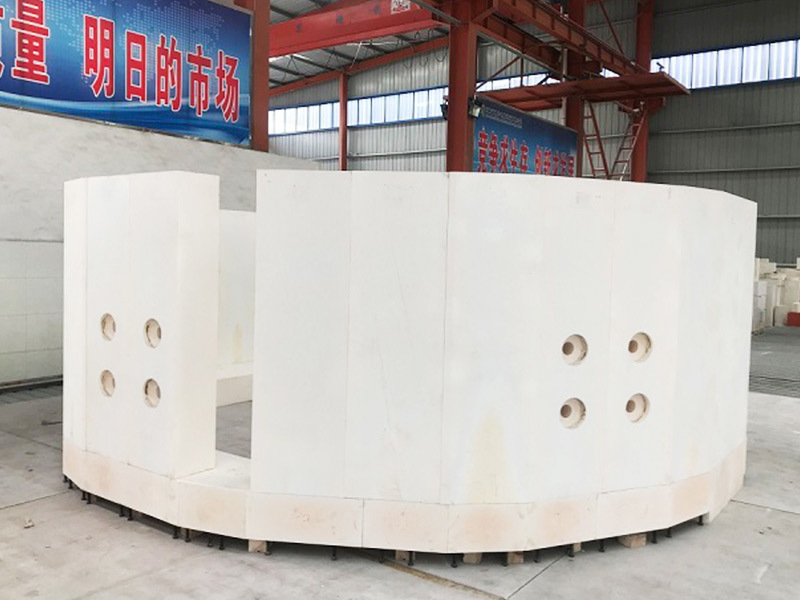Fused cast zirconia corundum bricks
Classification:
Product Introduction
Fused zirconia corundum brick is commonly known as white iron brick, it is the most important refractory material to ensure the normal operation of glass melting furnace, the current glass melting furnace at home and abroad to improve the melting rate, prolong the kiln age, reduce the fuel consumption is mainly due to the use of this refractory material to be realised.
Fused cast zirconia corundum bricks can also be called corundum-oblique zircon products, and its main chemical components are Al2O3 50%~70%, Zr02 20%~40%, and the rest SiO2. The main mineral compositions are clinthinozircon (Zr02), corundum (α-Al2O3) and glass facies.
Oblique zircon crystallises to form the backbone of the brick body, with a high melting point of ZrO2 (2715 °C), good chemical stability, and strong resistance to acidic and alkaline media, especially the erosion of molten glass.
With the increase of ZrO2 content, the performance of fused zirconia corundum bricks is also improved, and the zirconium corundum bricks are generally divided into grades according to the amount of ZrO2, such as 33%, 35% and 40% grades, and are also divided into grades containing 30%, 40% and 50%, which are not uniform. At present, the most used products are products containing 33% zirconium, with a density of 3.1~3.4g/cm3 and a maximum service temperature of about 1700 °C.
Fused and cast zirconia corundum bricks are used in industrial kilns such as glass melting kilns, and the use parts in glass melting furnaces are masonry upper pool walls, small furnace flat ballasts, small furnace buttresses, tongue buttresses and breast walls.
The following issues should be paid attention to in use:
(1) Irregular changes in thermal expansion. The expansion curve of fused zirconia corundum brick has an anomaly around 1000 °C, and its internal ZrO2, crystal reversible crystal transformation, there is a large volume change, therefore, products containing ZrO2. It should not be used in parts around 1000°C where the temperature often fluctuates sharply. When baking the kiln, the temperature change should not be too large at 900~1150 °C, and generally should not exceed 15 °C/h, and the temperature should rise steadily. Some parts should be protected from blowing cold wind, and other bricks should be used to protect them from bursting.
(2) Shrinkage porosity. When pouring moulding, shrinkage holes often appear at the casting mouth, where the brick body has more pores, and the density is poor, so when the pool wall of the melting part of the glass is built, the shrinkage holes are facing the direction of the kiln, if the casting mouth is facing outward, when the brick body erodes to a very thin level, it will cause the leakage of the glass liquid accident. When used in the flame space in the upper part of the pool kiln, the service life is very long, and there will be no problem of running the glass liquid, so the casting mouth is used outward to prolong the service life.
(3) Eutectic. Therefore, when selecting refractory materials, it should be avoided to contact the two refractory materials with serious eutectic phenomenon in masonry, such as silica bricks under the fused zirconia corundum bricks, which are most susceptible to the erosion of fused zirconia corundum bricks.
Fused and cast zirconia corundum products for glass kilns are divided into three grades according to their zirconia content: the nominal content of zirconia of AZS-33 products is 33%; The nominal content of zirconia in AZS-36 products is 36%; The nominal content of zirconia in AZS-41 products is 41%. Products are divided into Y (first-class products) and H (qualified products) according to their physical and chemical indicators, allowable deviations of size and appearance indicators.
The allowable deviation of the size and appearance index of the special-shaped products shall be agreed upon by the supply and demand parties. The surface of the brick is not allowed to have serious sticky sand, and ferrosilicon is not allowed.
The allowable deviation of the size and appearance index of special-shaped products are agreed by both the supply and demand parties. The crack index of dense and non-shrinkage porosity products is agreed by the supply and demand parties. Mould sand and other smelts shall not be attached to the surface of the product.
| Projects | Physical and chemical indicators | ||||
| AZS33-Y | AZS36-Y | AZS41-Y | |||
| Chemical Composition % | Al2O3 | / | (Margin) | ||
| ZrO2 | / | 32~36 | 35~40 | 40~44 | |
| SiO2 | ≤ | 16 | 14 | 13 | |
| Na2O | ≤ | 1.45 | 1.45 | 1.30 | |
| (Fe2O3+TiO2+CaO+MgO+Na2O+K2O) | ≤ | 2 | 2 | 2 | |
| (Fe2O3+TiO2) | ≤ | 0.3 | 0.3 | 0.3 | |
| Bulk density (g/cm3) | ≥ | 3.75 | 3.80 | 3.95 | |
| Apparent porosity/% | ≤ | 1.5 | 1.0 | 1.0 | |
| Resistance to the erosion rate of molten glass at rest (Ordinary soda-lime glass, 1500°C×36h)/(mm/24h) | ≤ | 1.60 | 1.50 | 1.30 | |
| Initial precipitation temperature of glass phase/°C | ≥ | 1400 | 1400 | 1400 | |
| Bubble precipitation rate (ordinary soda-lime glass, 1300°C×10h)/% | ≤ | 2.0 | 1.5 | 1.0 | |
| Glass phase exudation (1500°C×4h)% | ≤ | 2.0 | 3.0 | 3.0 | |
| Thermal expansion rate (room temperature ~1000°C)/% | ≤ | Provide measured data | |||
| Bulk density(Kg/m3) | PT、QX | > | 3400 | 3450 | 3550 |
| ZWS | > | 3600 | 3700 | 3850 | |
| WS | > | 3700 | 3750 | 3900 | |
Key words:
Fused cast zirconia corundum bricks
Glass kiln with fused zirconia corundum bricks
AZS-33 bricks
AZS-36 bricks
AZS-41 bricks
Related Products
Product inquiry


